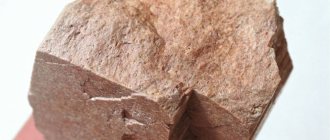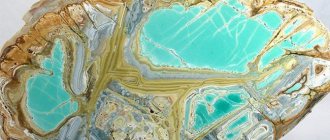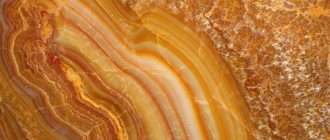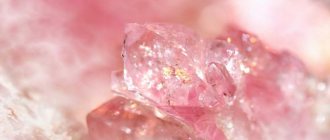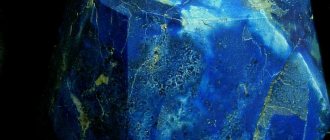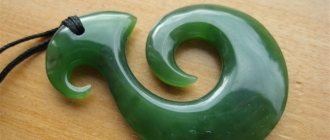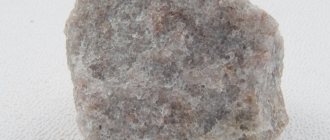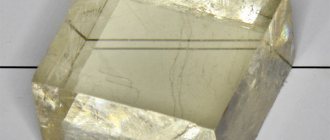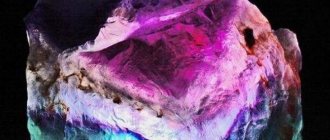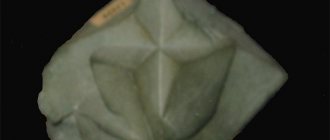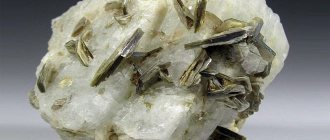History and origin
The first finds and use of feldspar go back to ancient times. No one knows the exact time when the mineral was discovered. There are only scattered references to the stone in handwritten sources from different times.
The name “feldspar” is German, although it has Swedish roots. This is because the agricultural land located on the lands of modern Sweden is completely strewn with feldspar. Mineralogists believe the origin of the name is Swedish-German, where “feldt” means “arable land” and “spath” means bar. In 1740, the German term "feldspat" was introduced. In addition, scientists claim that the Russian-language term “cleavage” should have been pronounced as “spatnost”.
In mineralogy, feldspar is understood as a whole group of minerals. The origin of the stone is magmatic. In fact, feldspar is the rock-forming material of our planet. In its pure form, this nugget is inconspicuous. However, pure spar is rare. The bulk of stones include various impurities, which separates them by chemical composition, type, and name.
This is interesting! The Moon is rich in feldspar, like the Earth. This mineral is not uncommon in outer space - most meteorites contain feldspar.
The fact that spar has been used by people at all times is confirmed by archaeological finds during excavations. Nugget jewelry made by people of ancient civilizations has been found in Egypt and other Eastern countries. Scientists of all eras have studied the capabilities of this mineral. Research in this area is still being carried out.
§ 1. Basic concepts. Mineral and rock
The earth's crust consists of rocks, which in turn are composed of minerals.
| Minerals differ from other substances in two ways: 1) only homogeneous (homogeneous) bodies are classified as minerals; 2) minerals include only products of natural physical and chemical processes. |
The most important properties of minerals.
For the recognition of minerals, the following properties are of greatest importance: chemical composition, crystallographic outlines, color, luster, fracture, density, hardness and cleavage. The last two properties, as well as weathering, coefficient of thermal expansion and some others characterize the technical quality of individual minerals.
The color of minerals is very variable, however, minerals are divided into light-colored (quartz, feldspars) and dark-colored (olivine, pyroxenes and amphiboles).
The luster of minerals can be different: metallic (pyrite), glassy (quartz), pearlescent (muscovite), silky (fibrous gypsum), greasy (talc), etc.
| A fracture is a type of surface on mineral fragments. Fractures are distinguished: conchoidal (quartz), earthy (chalk), granular (marble), hooked and splintered, etc. |
| Cleavage is the ability of some minerals to split when struck in certain directions and produce smooth planes on the fracture surface, called cleavage planes. Cleavage is distinguished: 1) very perfect (in mica), when the mineral splits into thin films, 2) perfect (in feldspars, calcite), when the fragments are limited to regular planes, and 3) imperfect (in quartz), when when splitting, uneven surfaces. Cleavage can appear in one direction (mica), two (feldspars) and three directions (calcite, rock salt). |
| Hardness is the ability of a mineral to resist scratching. To diagnose minerals, the Mohs relative hardness scale is used, where 10 minerals (talc, gypsum, calcite, fluorite, apatite, orthoclase, quartz, topaz, corundum and diamond) are arranged in order of increasing hardness, so that each subsequent mineral leaves a scratch on the previous one . |
| Weathering is the susceptibility of minerals (as well as rocks) to changes under the influence of various atmospheric factors. |
| Rocks are natural formations consisting of either the same mineral (monomineral rocks) or several minerals (polymineral rocks). Unlike a mineral, a rock is characterized by a significant volume, structure and form of occurrence. |
According to genetic classification, all rocks are divided into three groups:
- igneous or igneous (primary) rocks;
- sedimentary (secondary) rocks;
- metamorphic rocks.
Mining locations
Feldspars are mined everywhere on almost all continents of the Earth. However, each group of mineral has distinct conditions of origin and occurrence. The main share of mining is carried out in parallel with granite. The nugget is mined in industrial quantities in the following areas:
- Russia.
- Sweden.
- Ukraine.
- Poland.
- Norway.
- Kazakhstan.
- Japan.
- Germany.
- Islands of Madagascar.
Jewelry spar occurs in other places:
- Adularia is mined high in the mountains of India, Tajikistan, and the island of Sri Lanka. The higher above sea level the mineral lies, the better and more expensive the gem.
- Labradorite is found on the lands of Greenland, India, Ukraine, Canada, Finland, and China.
- Amazonite occurs in the territories of Brazil, African countries, India, and Canada.
- The Australian continent, America, Kyrgyzstan, and the mountain ranges of Italy and Mexico are rich in orthoclase.
Feldspar is highly valued in industry. The nugget is used to make glass, ceramics, abrasives, some types of rubber, as well as in electronics and in the creation of cosmetics.
Production
The origin of feldspars is mainly volcanic and igneous.
Minerals are mined all over the world (except for the Arctic and Antarctic).
Deposits of the most common group of minerals are:
- USA;
- Sweden;
- Madagascar;
- India;
- Ukraine.
Russia is rich in such minerals:
- Transbaikalia;
- Chelyabinsk region;
- Sverdlovsk region;
- Tyva;
- Chukotka.
Potassium feldspars are mined mainly from pegmatite ores. Along the way, columbite, mica, and beryl are mined.
Potassium feldspars
Physical properties
Feldspars of any group are identical in physical properties, but different in chemical composition. The mineral is a plate-shaped stone, heterogeneous in composition, often formed in the form of symmetrical twin crystals.
| Property | Description |
| Formula | { K, Na, Ca, sometimes Ba }{ Al2Si2 or AlSi3 }O8 |
| Hardness | 5 — 6,5 |
| Density | 2.54—2.75 g/cm³ |
| Refractive index | 1,554—1,662 |
| Melting temperature | Albita-1100°С, Anortita-1550°С |
| singonia | Monoclinic or triclinic. |
| Cleavage | Perfect. |
| Kink | Stepwise uneven. |
| Shine | Glass. |
| Transparency | From translucent to opaque. |
| Color | From white to bluish or reddish. |
A nugget is formed in an acidic environment due to magmatic processes occurring in the earth's crust. Feldspars are endowed with an iridescent effect, the luster of the minerals is glassy or mother-of-pearl. Any of the spars is destroyed by hydrofluoric acid. Hydrochloric acid is also destructive for plagioclases.
Also read: Grandidierite is a trichroic stone
Almost all feldspars are representatives of solid solutions of the ternary system of the isomorphic series K[AlSi3O8] - Na[AlSi3O8] - Ca[Al2Si2O8], the last members, respectively, are orthoclase (Or), albite (Ab), anorthite (An). There are two isomorphic series: albite (Ab) - orthoclase (Or) and albite (Ab) - anorthite (An).
Properties and uses of stone
People use feldspar for a variety of purposes:
- for the production of glass and ceramics;
- for the production of rubidium and aluminum;
- in cosmetology;
- for the production of abrasives;
- in the production of mineral paints;
- for decorative purposes for making crafts and jewelry;
- for exterior decoration of buildings (labradorite, amazonite);
- for processing radioactive waste.
Physicochemical characteristics
The chemical formula of feldspar is complex - (K, Na, Ca, sometimes Ba)(Al2Si2 or AlSi3)O8. It indicates that it is an aluminosilicate and contains the following components:
- alumina;
- silica;
- potassium oxide;
- sodium oxide;
- calcium oxide.
Lithium, cesium, lead, barium, boron, rubidium, etc. may be present as impurities. Physical and chemical properties of feldspar:
- hardness 6.0–6.5 points;
- density 2.54–2.75 g/cm3;
- glass shine;
- the fracture is uneven, stepped;
- melting temperature from 1100 °C to 1500 °C;
- iridescence effect;
- layering;
- insoluble in acids, except concentrated hydrochloric and hydrofluoric acids.
The structure of feldspar is a silicate with a three-dimensional framework of aluminum and silicon, which is endlessly duplicated. The crystal lattice is based on a tetrahedron (triangular pyramid).
Here's a video of what the mineral looks like:
Medicinal properties
Feldspar is actively used in lithotherapy. He is capable of:
- restore mental balance, help fight depression (orthoclase, amazonite and adularia);
- reduce pain in arthritis, arthrosis, osteochondrosis (Labrador);
- normalize vascular tone, have a positive effect on heart function (amazonite);
- help with liver diseases (albit);
- have a calming, hypnotic effect (andesine, amazonite);
- improve skin condition, especially with skin diseases (amazonite);
- help with kidney diseases (albit, labradorite).
The magical properties of feldspar
According to magicians, the mineral affects the owner in a positive way:
- enhances concentration on business, increases performance;
- sets a peaceful mood, helps to find a compromise in controversial and conflict situations;
- develops positive qualities in a person;
- improves the climate in the family;
- increases curiosity, gives energy to learn new things.
Feldspar is incompatible with people who have evil thoughts and intentions; it will not help them.
Labradorite has the most pronounced magical effect.
To watch a video review on the topic:
Suitable by name and zodiac sign
The influence of feldspar on representatives of different zodiac signs is ambiguous:
- Expressive but fearful of failure, Taurus will overcome the unpleasant emotions of this. In the future, they will be able to cope with assigned tasks more confidently.
- Naturally gifted Virgos will feel a surge of creative energy, which will help them decide on a profession. The need for self-realization can push you to radically change your field of activity.
- For impulsive but self-confident Capricorns, feldspar will become a symbol of good luck in love affairs. By adding attractiveness to the sign in the eyes of the opposite sex, the mineral will make it irresistible and help it find love.
- Dreamy Cancers will be able to achieve what they want by making ideas and dreams come true. The stone will give you strength to reach your goal.
- Hardworking Scorpios will receive help from the gem in overcoming major problems and will find new solutions. This will not go unnoticed in the eyes of your superiors - your career will go uphill.
- For emotional Aries, it will direct energy in the right direction. Will help you do your work more efficiently.
- Leos prone to laziness will be given tone and self-discipline. Those around you will note the desire for a goal in a representative of the sign.
- Silent Pisces will become more sociable and sociable. They will learn to conduct a conversation in a way that gets their way.
- Melancholic Libra will feel support in the form of a change in perspective to a positive one. This will give you energy and strength.
- Cynical, but filled with the desire for a goal, Sagittarius will find an ally in the stone, leading to their plans. It will help you become more sensitive and responsive, which will have a positive impact on your relationships with others.
Feldspar should not be worn by Aquarius and Gemini. It will weaken your willpower, which will lead to unpleasant consequences.
Astrologers claim that certain types of gems are suitable for people with the names:
- Amazonite - Lyubov, Valentina;
- adularia - Roman, Gleb, Svetlana;
- Labrador - Yana, Zinaida.
Compatibility with other stones
For any gem there are good, neutral and undesirable combinations with other stones:
- Adularia is combined with lapis lazuli, onyx, pearls, and sapphire. It should not be combined with agate and malachite.
- Labradorite can be worn with beryl, rose quartz, aquamarine, topaz, amber, and jade. Incompatible with ruby, diamond.
- For Amazonite, fire opal, aquamarine, and rock crystal are the optimal combination. Onyx, agate, black and white sardonyx - vice versa.
Amethyst is a good neighbor for most spars; garnet and jasper are undesirable.
Varieties and colors
“Pure blood” spar is transparent and unremarkable. Impurities of various elements give the stone a unique appearance, as well as individual, unique properties.
Feldspars are divided into groups, each of which includes a specific category of stones.
Plagioclases or sodium-calcium spars
Metamorphic as well as igneous rocks are mainly created by plagioclases. The latter, sometimes, are almost 100% composed of plagioclase. The group of plagioclases includes:
- Oligoclase;
- Labrador;
- Andesine;
- Albite;
- Anorthitis;
- Bitovnit.
Of all plagioclases, albite is the most resistant to destruction.
Potassium spar
This group of spars is the main component of acidic igneous rocks - syenites, granites, as well as gneisses, which are classified as metamorphic rocks. Compared to plagioclases, they are more resistant to damage. Representatives of this category of mineral tend to be replaced by albite under favorable conditions. Potassium spars are considered:
- Adularia;
- Sanidin;
- Orthoclase;
- Microlin;
- Amazonite (light green microline).
All minerals of the potassium group are identical in chemical composition, differing only in the structure of the crystal lattice. Albite inclusions give potassium spars a moonlit effect.
Hyalophanes or potassium-barium spars
This group includes one single mineral - celsian. This is a very rare cream-colored stone that is sought after by collectors all over the world.
The color range of some varieties is quite diverse:
- Labradorite has a black and blue base, shimmering with all the colors of the rainbow. The second name of the stone is “cold rainbow”. This name was given to the mineral for the coldness of its shades and the lack of saturation of rainbow colors.
Labrador - Orthoclase is distinguished by a pastel palette - calm shades of pink, white, with the presence of gray. There are also yellow and red specimens.
Orthoclase - Amazonites are gray and green gems.
Amazonite - Microlins are otherwise called “sun stones”. The palette of shades is appropriate - fiery orange, bright red tones.
Microliths - Adularia is the most unusual mineral, comparable to the Moon both in color and in its mysterious internal glow. The second name is “moonstone”.
Moon rock
Some transparent rare samples of orthoclase contain inclusions in the form of sparkles or sparkles.
What is feldspar
Feldspar appears as a transparent, translucent or opaque flake stone that comes in a variety of colors but varies in luster. It is soft, subject to mechanical stress, and is destroyed by impact on a hard surface.
Varieties and colors of feldspar
Main subgroups of the mineral:
- plagioclases – contain calcium and sodium, differ in the structure of their crystal lattices;
- potassium spar – contains potassium;
- potassium-barium spar (hyalophane) - the only representative (celsian) contains barium, is a rare cream crystal, goes into private collections.
The 1st subgroup includes:
- albite is the most common representative of blue, blue, violet colors with an admixture of gray;
- andesine – white, gray with a glassy sheen, grows in clusters with other stones;
- anorthite – contains up to 90% aluminum, yellowish, reddish, white, gray or colorless;
- bitownite is a pale yellow, whitish, sometimes transparent calcareous mineral, rarely suitable for jewelry;
- oligoclase - is a compound of albite (70–90%) and anorthite (10–30%) of white, silver, yellowish, bluish tints;
- Labradorite - one of the most beautiful representatives of feldspar, has other names - iris, lynx eye; iridescence from white to blue is called iridescence.
The 2nd subgroup includes:
- adularia is a milky-whitish moonstone that looks like a night luminary;
- orthoclase - comes in any degree of transparency and all shades of yellow;
- microcline (amazonite) – green, brown, white, pink crystals;
- Sanidine is a colorless, gray, white, yellowish-red mineral.
To view a photo gallery of stones:
Plagioclase
Potassium spar
Hyalophane
Albite
Andesine
Anorthitis
Bytovnit
Oligoclase
Labrador
Adularia
Orthoclase
Sanidin
Other varieties of spar
Spar is a rock. Based on the substances it contains, there are 3 types:
- Smithsonite - zinc spar, a common and beautiful bluish-green mineral;
- calcite - lime spar, a natural form of calcium carbonate, is distinguished by its transparency, a fairly wide range of colors from whitish to honey-colored;
- siderite - iron spar, iron carbonate, there are specimens of red, greenish, gray, yellow, white colors.
Also see pictures of the species:
Smithsonite
Calcite
Siderite
Medicinal properties
Since feldspar is a multifaceted mineral, its use in lithotherapy depends on the type of stone. Each of the gems is endowed with special, unique properties, which means it affects the human body in its own way.
Experts use several types of feldspars to treat various diseases:
- Adularia and orthoclase are famous as a remedy for epileptic and mental seizures. These minerals have a beneficial effect on the human nervous system.
- Albit copes with kidney and liver diseases.
- Labrador is an assistant for problems with the musculoskeletal system. In addition, the gem has a calming effect and also treats kidney diseases.
- Amazonite with heliolite (microline group) – treats the cardiovascular system and blood diseases. These minerals also relieve nervous tension and depression. Problems with the skin, in particular cosmetic ones (wrinkles), are also within their reach.
The effect of andesine on humans is equivalent to the effect of sedatives.
§ 2. Igneous rocks
Processes in education and classification
Igneous (primary) rocks were formed as a result of the eruption and cooling of magma (rock melt located in the bowels of the earth). If the rock was formed according to the scheme shown in Fig. 1a, then it is called deep or intrusive . If the rock occurred as a result of cooling of magma that poured out, according to the diagram in Fig. 1b, then it is called outpoured or effusive .
In addition to these two groups of rocks, which are massive, when lava was ejected from volcanoes in the form of splashes and splashes, loose volcanoclastic rocks were formed: volcanic ash and sand.
The classification of igneous rocks, the processes during their formation and the main representatives are shown in Fig. 2.
Mineralogical composition of igneous rocks
All the main rock-forming minerals of igneous rocks can be divided into four groups: 1) quartz, 2) feldspars, 3) micas and 4) dark-colored. The latter, in contrast to the almost colorless quartz and feldspars, are highly colored. A comparison of minerals of igneous rocks is given in table. 1.
Quartz . In rocks, quartz (crystalline silica - SiO2) is predominantly present in the form of ordinary quartz - opaque or only slightly translucent dense grains, having a glassy sheen and painted in a variety of colors.
It is very typical for quartz that acids do not affect it, with the exception of hydrofluoric acid. Due to its chemical inertness, quartz almost does not weather, as a result of which it is the last remnant of the destruction of the rocks containing it. While other minerals turn into fine destruction products (clay), quartz forms sand.
Feldspars. Feldspars include a group of many minerals that have similar physical and chemical properties. All minerals of this group are characterized by light shades of various colors. They differ from quartz in their lower hardness (6 on the Mohs scale) and their inherent perfect cleavage.
Feldspars are divided into two groups: 1) orthoclase , which in Greek means straight-cut, and 2) plagioclase , which means obliquely split.
In orthoclase, the cleavage planes form a right angle, while in plagioclase they form a different angle (about 86°).
In terms of chemical composition, orthoclase is a potassium aluminosilicate, and plagioclases are a series of minerals, the extreme members of which are albite (sodium aluminosilicate) and anorthite (calcium aluminosilicate). All intermediate terms between albite and anorthite are considered as isomorphic mixtures of both in various proportions.
If we turn to the chemical formulas of plagioclases, it is easy to see that in albite, the formula of which includes 6SiO2, silica should predominate (its content in albite is 68.68%), and vice versa, in anorthite, the formula of which includes only 2SiO2 , silica is already in a subordinate amount (43.16%). Therefore, albite and oligoclase should be classified as acidic plagioclases, and anorthite with adjacent bytownite should be classified as basic. It goes without saying that orthoclase should be considered as an acid feldspar. All feldspars are relatively easily weathered and converted into kaolin, the purest type of clay.
Mica . Of the micas, biotite (black mica) and muscovite (transparent mica) are the most important as rock-forming minerals. Mica differs from other minerals in its very perfect cleavage and low hardness (2-2.5).
If micas are included in a rock in significant quantities, they greatly worsen its mechanical properties; With a high mica content, it also becomes difficult to obtain a good polished surface.
Pyroxenes and amphiboles . Pyroxenes and amphiboles are two groups of similar minerals, each of which has several representatives. For pyroxenes, the most characteristic mineral is augite, and for amphiboles - hornblende, which is why pyroxenes are often called augites, and amphiboles - hornblende.
The best distinguishing feature of these minerals is the angle formed by the cleavage planes; in hornblende it is 124°, and in augite it is 87°. Both amphiboles and pyroxenes differ from other minerals in their very dark color and high density from 3.0 to 3.6 g/cm3. In terms of weathering, they are superior to feldspars.
Consideration of the table. 1 allows us to draw several very important conclusions.
The content of silica in minerals decreases as you move down the table from top to bottom. At the top of the table is quartz, consisting of 100% SiO2, at the bottom are dark-colored minerals with a low, about 35-50%, silica content. Accordingly, the acidity of igneous rocks will depend on the predominance of certain minerals.
Igneous rocks are composed primarily of various silicates and aluminosilicates! In this they differ from sedimentary rocks, in which salts of other acids, primarily carbonic, partly sulfuric, etc., predominate over salts of silicic acid (silicates).
The color of minerals varies from light (at the top of the table) to dark (at the bottom), so that all acidic rocks will be weakly colored, all basic rocks, on the contrary, will be very strongly colored.
Comparison of the density of rock-forming minerals shows us that rocks with a high content of dark components will be characterized by greater weight than acidic, light-colored rocks.
In terms of resistance to weathering, the least desirable in the rock are feldspars, which weather very quickly.
Structure of igneous rocks
The most characteristic of igneous rocks are two structures: granular-crystalline (granite) and porphyry (Fig. 3). The structure of a rock is called granular-crystalline when individual mineral grains are visible to the naked eye and are approximately the same in size.
There is a type of granular-crystalline structure called porphyritic, i.e. similar to porphyry. When a rock contains very large phenocrysts and the surrounding groundmass is granular-crystalline, it resembles a greatly enlarged porphyry structure.
The granular-crystalline structure is characteristic primarily of deep-seated rocks, since it could only be obtained by slow cooling of the rock, when nothing interfered with its complete crystallization. On the contrary, the porphyry structure is inherent in erupted rocks. The presence of phenocrysts in the latter can be explained by the fact that the crystallization of magma began in the bowels of the earth, when the temperature dropped very slowly. After the outpouring of magma onto the surface, the remaining mass solidified, but only with fairly rapid cooling, which is why it turned out to be poorly crystallized.
Even-grained rocks are technically superior to rocks with a porphyritic structure, and technical properties (mechanical strength, resistance to weathering) usually increase with a decrease in the average grain size. Rocks with a porphyry structure are technically less expensive, the more glass they contain. Glassy rocks (for example, pure volcanic glass - obsidian) are very fragile and do not withstand temperature fluctuations well.
Classification of igneous rocks by structure and mineralogical composition
The classification of igneous rocks by structure and mineralogical composition is presented in table. 2.
In the central part, three rows of the table show the main igneous rocks used as building materials. Under each name of deep-seated rocks, two representatives of the erupted rocks are recorded, which are complete analogues of them in mineralogical composition and differ only in structure. The same magma could solidify either at depth or on the surface of the earth. We can read the mineralogical composition of the rocks in the same column of the table immediately above them. For example, about the mineralogical composition of granite and its analogues (quartz porphyry and liparite) we read: there is quartz, orthoclase is present from feldspars, there are few dark-colored minerals. If we follow the table from left to right.
looking at the mineralogical composition, we will see that there is no quartz (the most acidic mineral), except in granite and its analogues, in other rocks. The content of dark-colored minerals (the most basic) increases from granite to gabbro, and in the group of feldspars the representatives change so that in granite and its analogs there is the most acidic representative - orthoclase, and in gabbro, diabase and basalt - the most basic representative of plagioclases - bytownite or anorthitis. As we move from left to right, there is a decrease in SiO2 content, in other words, a decrease in the acidity of the rocks. If we recall what was said regarding minerals (see Table 1), we can also add that the rocks occupying the right side of Table 2 are characterized by a higher density and darker color compared to the rocks located on the left side of the table. In parallel with the increase in the content of dark-colored minerals, the mechanical strength of the rocks increases.
Intrusive (deep) rocks
All intrusive rocks: granite, syenite, diorite and gabbro are very similar to each other in their technical properties. They all have high density, negligible porosity and relatively high mechanical strength.
Granite. The average mineralogical composition of granite is as follows: quartz from 20 to 40%, orthoclase (rarely alkali plagioclase) from 40 to 60%, mica or hornblende (rarely augite) from 5 to 20%.
The structure of granites is predominantly granular-crystalline, otherwise granitic (the name granite comes from the Latin word granum - grain) and in some cases porphyritic. An example of granites with a porphyritic structure is the Finnish rapakivi granite, in which orthoclase phenocrysts the size of a hen's egg or more are found. The red granites of most buildings in St. Petersburg have a porphyry-like structure.
The color of granites is determined by the color of its main component—orthoclase. Depending on the color of the latter, it can be gray, yellowish, reddish, or meat-red.
Technical properties of granite . The density of granite ranges around 2.7 and increases as the amount of dark-colored minerals in the rock increases. Temporary compressive strength for granites (as in general for all natural stones) varies within a very wide range from 80 to 330 MPa. Granites with a fine-grained structure have greater strength. An increase in mica content reduces the mechanical strength of granite; in addition, mica prevents the production of a good polished surface, since it is easily chipped, leaving cracks. On the contrary, an increase in the content of pyroxenes or amphiboles is desirable - the mechanical properties and ability of granites to accept polishing increase.
The weathering resistance of granite is generally quite high. Only some of its representatives, which include the Finnish rapakivi granite (which means rotten stone), which was previously widely used in the construction of St. Petersburg, are destroyed quite quickly. Granite resists abrasion well, which is why it is a valuable material for the manufacture of stair steps, sidewalk slabs, and road pavement. In deep rocks, abrasion resistance increases with increasing amounts of dark-colored minerals.
The processing and finishing of igneous rocks is so expensive (due to the high hardness of the minerals they contain) that they are rarely used in ordinary buildings, but are used primarily in structures that are especially important or of great architectural value.
Application of granite. Granite is used in the form of piece stones for the foundations of expensive buildings, for retaining walls, for the construction of embankments, for external cladding of walls. Paving slabs and steps are often made from it. Larger pieces of granite are used for columns of buildings and monuments. It is used in small pieces for making pavements; for crushing into crushed stone, etc.
Syenite. Differs from granite in the absence of quartz; consists of orthoclase and a dark mineral, most often hornblende.
It is used like granite, differing from the latter in lower hardness, increased viscosity, especially with a significant content of hornblende or augite, and the ability to better accept polishing. It is a valuable material for paving roads and producing crushed stone.
Diorite . It consists mainly of acid plagioclase and hornblende, less commonly biotite and augite; plagioclase constitutes on average 75% of the rock.
According to the change in mineralogical composition, diorite is characterized by a darker color than granite and syenite, a higher density (2.75-3.0) and compressive strength.
Diorites are used as road material (paving stones, crushed stone), in the form of piece stones and as a decorative material (due to their ability to be highly polished).
Gabbro . Significant minerals in gabbro are basic plagioclase (about 50%) and pyroxene, less commonly hornblende. The color is in most cases dark green in various shades. Density 2.8-3.1, compressive strength in fine-grained varieties 200-280 MPa, falling in coarse-grained varieties to 100 MPa. Gabbro is difficult to process, but takes polish well.
Of the decorative varieties of plutonic rocks, labradorite, a coarse-grained variety of gabbro, characterized by a predominance of labradorite plagioclase over other minerals, deserves special mention. Labradorite is distinguished by its so-called iridescence, i.e. the play of reflections of various colors: blue, light blue, green and others. Labradorite was, for example, used for the interior cladding of the Lenin Mausoleum, as well as for the cladding of the partition panels between the windows of the “House of Books” in St. Petersburg.
Effusive (outpoured) rocks
Erupted rocks are characterized by the ability to produce highly porous varieties (for example, pumice). The formation of such porous varieties is explained by the release of gases that saturated magma in the bowels of the earth. When the pressure decreased, as a result of the eruption of magma, the gases dissolved in it were released and foamed the mass as it solidified. Effusive rocks can be both porous and dense, in contrast to intrusive rocks, which, due to the conditions of their formation at depth, are not able to produce porous varieties.
Quartz porphyry and liparite. Quartz porphyry and liparite are similar in chemical and mineralogical composition to granite. They differ from the latter in their porphyry structure. The phenocrysts in them are quartz and, often, feldspar. The glassy variety of quartz porphyries and liparites is called volcanic glass or obsidian.
The color of quartz porphyries and liparites is gray, yellowish, pale red and brick red. Quartz porphyry and liparite differ from each other in their age and freshness of their constituent minerals; quartz porphyry has undergone changes and is somewhat darker than liparite.
The technical properties of quartz porphyries and liparites increase with a decrease in the number of phenocrysts in them. Therefore, dense felsites (rocks without phenocrysts) belong to the best grades of building stone; their mechanical strength reaches 280 MPa. The least advantageous is the glassy structure, because the rock in this case is brittle and is easier to weather. All of the above can be extended to other effusive rocks.
Quartz porphyries and liparites are quite widely used as piece stones and as decorative and ornamental materials, when they have a beautiful color and pattern.
Orthoclase porphyry and trachyte are extrusive analogues of syenite. They are distinguished from previous erupted rocks by the absence of quartz. They are characterized by increased porosity and, due to this, a relatively low volumetric mass (2.20-2.61) and low temporary compressive strength, on average 60-70 MPa. The color is gray to greenish-gray, yellowish and reddish.
These rocks are easier to process and wear out faster than the previous ones. Trachyte, due to its porous, cellular structure, cannot be polished, and due to its inherent roughness (trachyte in Greek means rough), it binds well to mortars.
Porphyrite and andesite are identical in mineralogical composition to diorite. Their color ranges from light gray to dark gray, and porphyrites are usually characterized by greenish tones. The volumetric mass is in the range of 2.56–2.85 g/cm3; temporary compressive strength ranges between 120-240 MPa. They are used as building stone for a wide variety of purposes.
Diabase and basalt. Diabase and basalt are identical in the mineralogical composition of gabbro and, due to the abundance of dark components in them, are characterized by an almost black color and dull dull appearance. Diabases are a product of more ancient times, while basalts are younger rocks.
Diabase is an excellent material for paving streets, for which it is used in the form of diabase blocks (paving stones). The mechanical strength of diabases almost always exceeds 200 MPa.
Basalt is the heaviest and most durable of all the eruptive rocks examined, its bulk mass is 2.7-3.3 g/cm3, and the strength of the best samples can reach 500 MPa, which is superior to deep-seated rocks. Basalts are characterized by high fragility, as a result of which they split relatively easily.
Basalt is highly polished, but due to its high hardness it is difficult to process.
Basalt is used both in road construction and for critical engineering structures. Basalt is a relatively fusible rock, therefore it is used to produce products by casting. Thermal insulation and acoustic materials based on basalt wool are used in construction.
Volcanoclastic rocks
Lava is usually called the fiery liquid products of volcanic eruptions. Lavas contain in a dissolved state a significant amount of gaseous products, which either manage to be released before the lava hardens (dense lavas) or foam it, giving it a porous or bubbly structure.
In addition to flows of liquid lava, volcanoes during eruptions emit colossal amounts of the same lava in a crushed state (volcanic sand and ash) into the air. The latter sometimes remain in a loose state (pozzolana), and sometimes undergo subsequent cementation, turning into more or less dense rocks called volcanic tuffs. Finally, when loose products of volcanic activity are mixed with liquid lava during volcanic eruptions, the rock is called tuff lava.
Artik tuff . Near the station Artik (Armenia), there are large developments of tuff lava of the Alagez volcano, which is not quite correctly called Artik tuff. Due to its technical properties, it is a valuable building material for the walls of residential buildings, however, it is obligatory to plaster the walls from the outside.
In appearance, Artik tuff is a porous, ringing rock when struck, mainly pinkish-violet in color with various shades. With a density of 2.56, the average volumetric mass of the rock is 1200 kg/m3. According to its low volumetric weight, Artik tuff is characterized by high porosity and low thermal conductivity; the true porosity of the rock is 57-60%, the coefficient of internal thermal conductivity in the dry state is two times less than for red brick; Accordingly, the thickness of a wall made of Artik tuff can be reduced by half compared to a brick one. The mechanical strength of Artik tuff is low, but quite sufficient for its use in the walls of buildings; its temporary compressive strength is on average 10.5 MPa. In addition, Artik tuff is quite frost-resistant, easy to process (it can be sawed with an ordinary saw) and holds nails driven into it well.
Magic powers
The magical properties of feldspar also vary according to species specialization. Since ancient times, shamans and sorcerers have used stone to perform various rituals. They believed that the mineral helped strengthen magical abilities, communicate with other worlds, and travel through time and space. Modern esotericists are also familiar with the abilities of feldspars.
Adularia
A stone of inspiration, vitality, self-confidence. An excellent talisman for creative individuals. The lunar gem gives a person clarity of thought, thanks to which the owner of the stone is able to clearly and without hesitation express extraordinary, bold ideas. In addition, adular is a protector from evil witchcraft and energy bloodsuckers.
Labrador
This nugget is considered the most magically powerful feldspar. Labradorite develops intuitive thinking, revealing a person's ability to foresight. However, such a talisman will only serve people of mature age who are able to control thoughts, actions, and emotions.
Orthoclase
A mineral that can warn the owner about moving changes in life. The stone changes color when a turning point occurs in family or other relationships.
Amazonite
A strong talisman for those who lack wisdom, self-confidence, courage, and prudence. The gem is designed to harmonize a person’s inner world and protect the owner from rash or wrong actions.
Even in ancient times, amazonite, together with orthoclase and adularia, were used as talismans of love and family well-being. These gems were and are given to young couples so that they can live in happiness, prosperity, and understanding.
Spar products
The most commonly found stones in jewelry are adularia (moonstone) and labradorite. Precious orthoclase is rare. Amazonite is also considered quite popular. The cut and setting of the stone greatly depend on its variety. The most common minerals are cabochon cut. A variety of metals are used for frames:
- silver (most common);
- yellow gold;
- White gold;
- black gold.
It is believed that the properties of most representatives of this group are fully revealed only in silver. Labradorite is most often seen as a pendant. Moonstone is most often used to create earrings and necklaces. Amazonite is common in the form of bracelets and rings. Earrings are usually made from orthoclase.
Compatibility with other stones
Each stone in the feldspar group has friendly minerals, as well as undesirable neighbors. In addition, there are combinations in which one or another gem maintains neutrality in relation to another.
The best partners for the adular are:
- onyx;
- lapis lazuli;
- pearl;
- amethyst;
- sapphire;
- coral.
Moonstone will be hostile to malachite, jasper, garnet and agate.
Labradorite is ideally combined with the following minerals:
- beryl;
- rose quartz;
- aquamarine;
- opal;
- topaz;
- amber;
- nephritis;
- amethyst.
You should not combine Labradorite with ruby, jasper, diamond, garnet or carnelian due to planetary incompatibility.
Amazonite is suitable for:
- rauchtopaz;
- jasper;
- fire opal;
- aquamarine;
- rhinestone.
The hostility of the planets does not allow Amazonite to be worn together with morion, agate, onyx or black and white sardonyx.
Labradorite, adularia and amazonite combine well with each other, complementing each other.
Story
Spars were formed as a result of volcanic eruptions, displacement of tectonic plates, exposure to wind and precipitation.
Two-thirds of the volume of the Earth's igneous rocks are minerals of the feldspar group. There are many of them on the Moon and in meteorites. Along with quartz, this is the most common rock on Earth.
The term “feldspars” refers to a group of four dozen minerals.
This is a Swedish-German tracing paper: “spat” is translated from German as a layered, plate-like stone (due to the presence of mica, the crystals are stratified into thin shiny plates); feldt - field, arable land in Swedish, feld - in German.
Used as a scientific term since the 18th century.
Archaeologists find jewelry and household utensils made of feldspars during excavations in Egypt and Asia (at the site of ancient Mesopotamia).
Even the ancient Chinese, who invented porcelain, added spar powder to clay to give strength to dishes, decorative vases and figurines, which made them famous throughout the world.
Jewelry with mineral
Jewelry types of feldspar include adularia, labradorite and amazonite. These minerals are used by craftsmen to make jewelry of different price categories. Each of the feldspar group stones has a different value in jewelry. You can buy products with the mineral at the following price:
- A silver ring with a moonstone costs from 15 thousand rubles, with labradorite - from 13,000, with amazonite - 12-14 thousand rubles.
- Earrings. A silver product with adularia starts at 19,000 rubles, with labradorite – from 16 thousand, with amazonite – about 12 thousand.
- A bracelet with an adularia in a silver frame will cost 32 thousand rubles on average.
- Suspension. A silver pendant decorated with labradorite starts at 7,000 rubles, and amazonite – at 11,000.
- Moonstone beads cost 16-35 thousand rubles, depending on the size of the beads.
Jewelry with feldspar jewelry is beautiful, as these stones have a pearlescent luster, are endowed with iridescence, are durable and easy to care for.
Application
Such a rich and accessible material as feldspars has found application in many industries.
- Potassium feldspars are used in the production of electrical ceramics. Porcelain teeth and opalescent glass are made from this variety.
- Labradorite is used for the production of facing tiles.
- Fluxes made from feldspar minerals are used in welding and metallurgy.
- Many feldspars have a slight abrasive effect when crushed. It is used in the production of toothpaste and cleaning products.
- Jewelry made from adularia, amazonite, and sunstone are inexpensive and beautiful jewelry.
- Many glazes and enamels require plagioclases.
- Potassium-barium feldspars are rare. Interesting specimens have value for collectors and mineral enthusiasts.
- The trace element rubidium is incidentally mined during the development of amazonite deposits.
How to spot a fake
Minerals such as feldspar are also counterfeited. For example, the most expensive adularia is considered to be a gem mined in Sri Lanka. Cheap imitation of such stones are glass or plastic.
It is not difficult to distinguish a natural moonstone from a fake:
- Look at the light through the stone - a real adularia will shimmer inside and play with colors. This effect cannot be faked.
- Glass or plastic will quickly heat up in the palms, natural stone will not.
- Natural adularia is smooth to the touch, soft like silk fabric.
It is almost impossible to counterfeit Labradorite due to the special play of colors - labradorization. This mineral shimmers with a full rainbow spectrum, creating the effect of a three-dimensional northern lights.
Amazonite is not so expensive that it can be counterfeited. But if you still have to doubt, then a proven method of determining thermal conductivity will come to the rescue - a natural mineral is always cool. In addition, a distinctive feature of Amazonite is its internal structure, due to which the surface of the stone is endowed with a pattern in the form of a grid of squares.
§ 3. Sedimentary rocks
Processes at origin and classification
Primary rocks located on the earth's surface, undergoing weathering, i.e. destruction under the influence of various atmospheric factors (air, water, temperature changes, plant and animal organisms, etc.) gradually turn into loose products of destruction, which are partly blown by the wind and ice, mainly water, are carried to lower places, closed water basins, seas and oceans, where they are deposited. The rocks produced in this way are called secondary or sedimentary. Water can transport destruction products in two ways: 1) mechanically - small particles in suspension, and large ones - rolling along the bottom; 2) in the form of an aqueous solution, since some products are formed in a water-soluble state. Depending on this, the formation of sediment can be either as a result of mechanical precipitation of particles from the flow, in the case of, for example, a strong slowdown in the flow of a river, or as a result of the release of a soluble substance into sediment, in the case of, for example, evaporation of water, or chemical reactions, in as a result of which insoluble compounds are formed. In addition, the formation of sediment occurs as a result of the vital activity of lower animals or plant organisms. Therefore, sedimentary rocks are divided into mechanical sediments or clastic rocks, physicochemical sediments and organogenic rocks (Fig. 4). Loose mechanical sediments (clay, sand, gravel, crushed stone) over time can be impregnated with some natural binder and cemented into a continuous monolithic mass. Cemented rocks include, for example, sandstone (cemented sand), conglomerate (cemented gravel), breccia (cemented crushed stone). Organogenic rocks, in turn, are divided into two groups. If they occurred as a result of the vital activity of animal organisms, they are called zoogenic, if plant - phytogenic. The former include limestone-shell rock, the latter - diatomite, tripolite, opoka. Diatomite was formed from accumulations of shells of microscopic algae - diatoms, consisting primarily of amorphous silica. Tripel is a rock secondary to diatomite, consisting of tiny grains of opal (a type of amorphous silica), round in shape. The flask is a product of compaction of diatomites and tripoli.
Mineralogical composition of sedimentary rocks
In sedimentary rocks, such as mechanical sediments, all the minerals of the primary rocks can be found. However, sedimentary rocks also have their own unique minerals. While in igneous rocks salts of weak acids (silicic and aluminosilicon) predominate, in sedimentary rocks silicates and aluminosilicates play a subordinate role, giving first place to salts of strong acids: carbonic, sulfuric, etc.
Of the minerals inherent only to sedimentary rocks, the following are of greatest importance: calcite, magnesite, dolomite, gypsum and kaolinite (Table 3).
Calcite (lime spar). The chemical composition of calcite is expressed by the formula CaCO3. It is found in limestones and marbles both in the form of perfectly formed crystals and in the form of a continuous mass of various compositions, granular or dense. Pure calcite is colorless, but in the presence of impurities it can be grayish, or white, or colored in light shades of blue, yellow, brown and other colors. The hardness of calcite is 3, it is characterized by very perfect cleavage in three directions.
Calcite is recognized by its reaction with hydrochloric acid, with which it reacts well even in the cold, releasing carbon dioxide with characteristic boiling. The solubility of calcite in ordinary water is negligible, but it dissolves well in water containing CO2. The latter circumstance must be taken into account when using building stone from rocks rich in CaCO3.
Magnesite and dolomite. In nature, magnesium carbonate is found in the form of the mineral magnesite (MgCO3) in the rock of the same name. As a natural building stone, magnesite is of no importance; it is mainly used for the manufacture of fire-resistant products and for the preparation of a binder - caustic magnesite.
Dolomite is a double salt of calcium and magnesium carbonates in chemical composition; its formula is: CaCO3 MgCO3. It is found both in crystalline form and in the form of granular and, less commonly, earthy masses in the rock of the same name. It is used, like magnesite, in the production of refractories and for the production of a binder - caustic dolomite.
The hardness of magnesite and dolomite is approximately the same, 3.5-4. They are distinguished by the action of hydrochloric acid. Magnesite does not react with hydrochloric acid under any conditions, and dolomite reacts, but poorly; When heated, it releases CO2. In rocks, calcite and dolomite accompany each other in various proportions.
Gypsum and anhydrite. Natural gypsum is an aqueous calcium sulfate salt CaSO4 ·2H2O. In addition to gypsum, there is an anhydrous salt - CaSO4, called anhydrite. Neither one nor the other, like natural stones, is used in construction. Gypsum can sometimes be a cementitious substance in sandstones. The main use of gypsum and anhydrite is to produce gypsum binders.
Kaolinite. Kaolinite (Al2O3 2SiO2 2H2O) is formed during the weathering of feldspars and is the main component of many clays. Pure kaolinite is white, earthy in appearance, slightly greasy to the touch and crumbles easily. Hardness 1.
Hydrous silica. The mineral composition SiO2 in sedimentary rocks, unlike igneous rocks, is present not only in a crystalline state (in the form of quartz), but also in an amorphous form, often in combination with water (SiO2 nH2O); An example is opal, which contains up to several percent water. Aqueous amorphous silica composes such sedimentary rocks as diatomite and tripoli, and is also a very strong natural cementitious substance, filling the spaces between grains of sand (in sandstones) and calcite (in limestones).
Structure of sedimentary rocks
The following types of structures are of utmost importance.
- Granular-crystalline (marble-like), when the rock consists of crystalline grains that are clearly visible to the naked eye or under a microscope. Depending on the average diameter of the grains that make up the rock, they are distinguished: fine (0.25-0.75 mm), medium (0.75-1.25 mm), coarse (1.25-2 mm) and coarse-grained structure ( 2-3 mm).
- Dense (aka fine-grained), when the grains are difficult to distinguish from each other even under a microscope. Conventionally, rocks with a granular-crystalline structure with a grain size of less than 0.25 mm are considered dense.
- Oolitic, when the rock consists of round balls of radial-concentric composition, cemented by one or another natural cementing substance. It is found in limestones, in this case called oolitic.
- Clastic (clastic), when the rock consists of fragments of minerals or rocks cemented by one or another natural cement. Sandstones, conglomerates and breccias have this structure.
- Foamy or tuff - the structure of porous rocks and others.
Loose clastic rocks
Depending on the particle size, the following loose rocks are conventionally distinguished: clay (<0.005 mm), dust (0.005-0.05 mm), sand (0.05-5 mm), crushed stone and gravel (>5 mm), cobblestones and boulders (large stones).
| Clay is a powdery, finely dispersed rock composed of so-called clay-forming minerals: kaolinite, montmorillonite (Al2O3 4SiO2 nH2O), hydromicas and some others, which consist of individual very fine particles (<1 µm), plate-shaped, interconnected by molecular forces attraction. |
Clays are formed as a result of weathering of rocks rich in feldspars (granite, syenite, gneiss, porphyry, etc.) (See also § 2, chapter 6).
Sand . Sands can be quartz, feldspathic, calcareous, dolomite, etc.
River sand, sea sand and lake sand are characterized by a rounded grain shape and a well-ground surface. Mountain and ravine sands have an angular shape and a rough grain surface.
Large quantities of sand are used for the preparation of mortars and concrete, in road construction for the construction of road foundations and the preparation of asphalt concrete. Huge quantities of sand are consumed by railway construction. Pure quartz (without impurities) sands are highly valued and used as raw materials in the glass, ceramic and metallurgical industries.
| Gravel and crushed stone. Crushed stone is a primary rock in relation to gravel; it is formed directly from the parent rock during its destruction and therefore consists of fragments that have an angular, sharp-edged, unrounded shape. Gravel is formed from crushed stone in river beds, along the shores of seas and lakes. The gravel particles have a rounded shape and a smooth surface. |
Gravel and crushed stone are used in road construction, as ballast for railways and as aggregate for concrete.
| Boulders (cobblestones). In construction practice, boulders are commonly referred to as rock fragments of glacial origin that are larger in size than gravel. |
Boulders are used in concrete and road construction to produce crushed stone. Cobblestone has long been used for paving streets. The largest boulders can be used as piece stone for buildings.
How to wear
All jewelry feldspars used in jewelry are completely different. However, the colors that nature has endowed them with are universal and suitable for almost any wardrobe and type of appearance.
The best option is the contrast of the image. Therefore, items with Labradorite are not worn with black clothes, and moonstone will not look good with white ones.
Evening dresses are well complemented by massive jewelry. During the day, neat, discreet accessories are more appropriate, especially for office style. Amazonite is not an evening stone.
Amazonite bracelet
Important! Moonstone is worn during the waxing moon phase. Then the mineral is fully revealed. When the Moon wanes, the adularia is fueled by the energy of the owner. Therefore, during this period it is better to hide the decoration away.
Adularia will look great on blue-eyed blondes. Amazonite will highlight those with green eyes. Labradorite is appropriate on mature women - this applies to both the appearance and the energy of the stone.
Lithotherapists advise
Products made from some varieties of the mineral (according to lithotherapists) have healing properties.
Amazonite is used for massages (anti-cellulite and general). The stone will help with osteochondrosis and arthritis, normalizes metabolic processes. Wear Amazonite jewelry regularly if you have dermatitis or eczema.
Amazonite
In the old days, it was believed that jewelry with amazonite healed the heart, thyroid gland, and lungs.
Labradorite (according to lithotherapists) will alleviate colds, strengthen the immune system, and help cure diseases of the genitourinary system.
Labrador
Important for many: lithotherapists believe that the mineral normalizes blood pressure and heals blood vessels. We recommend: ALBITE - “moon” stone
Sun stone (heliolite) is recommended for older people. It is recommended to wear jewelry at all times. Lithotherapists believe that the stone gives vigor and increases vitality. The stone has a tonic effect.
Heliolite
adularia in the East has been a stone that continues the family line. More precisely, he helped women get pregnant. After all, the main thing (from the point of view of an Eastern person) is to leave its continuation on earth. A moonstone amulet protects travelers.
Adularia
But the stone is not simple. He does not like duplicity, lies, deceit. Give jewelry with adularia to harsh, tough, cold people. The mineral will help awaken the warmth of the soul and compassion for others in the owner of the jewelry.
How to care
Feldspars need careful care. It doesn’t matter whether it’s Labradorite, Amazonite or Adularia. Recommendations for caring for spar:
- These minerals cannot withstand physical stress, so mechanical cleaning is prohibited for them. Ultrasound and the use of any chemicals are also unacceptable. It is enough to wash the products under running water or a weak soap solution, wiping them with a soft cloth afterwards.
- Store separately from other jewelry, wrapped in a soft cloth.
- Before doing housework, going to the gym or going to the beach, you should take off your jewelry. Amazonite is especially sensitive to sunlight - the stone loses color irrevocably.
Labradorite, like adularia, is closely associated with the moon. Therefore, these minerals require periodic recharging with moonlight.
Calcium plus sodium
List of common plagioclases
The second subgroup containing feldspars is plagioclases. They contain calcium (partially replaced by sodium), hence the name - calcium. These include:
- anorthite (a white-gray or yellowish-red rock-forming mineral for basalt and other igneous rocks);
- albite (white, purple, gray; other names are belomorite and peristerite);
- andesine (name from the location - the Andes mountains in South America; colors - yellow-green, red, gray);
- bytownite (belongs to calcareous plagioclases, similar to labradorite);
- oligoclase (a mixture of anorthite and albite; color – brown, greenish, yellow);
- labradorite (gray with a play of colors; other names are lynx eye, iris, sisyak, tavusit).
For jewelers
The last mineral on the list is labradorite, which has a blue iridescence. Therefore, the stone became valuable to jewelers. Spectrolite is a variety of it that shimmers with rainbow highlights.
Also known are solar labradorite (golden highlights) and black (dark blue glow). Read the detailed description in the article “Properties of Labradorite Stone”.
Faceted bytownite is sometimes found in jewelry. These are rare examples that are prized by lovers of uniqueness. Usually the stones are made into flat ovals and cut into cabochons.
Ceramics and industrial applications
Basically, all plagioclases are used for the manufacture of ceramic dishes, boxes, vases, figurines and other souvenirs. Products made from transparent and translucent varieties with optical effects (iridation and opalescence) are especially beautiful and therefore expensive. Deposits of these feldspars operate in Kenya, Japan, Italy, and Sweden. In Russia, developments are underway on the Kola Peninsula, Karelia and the Urals.
Another area of application is the metallurgical industry. Additions of plagioclase to fluxes during welding facilitate the process. Every morning we brush our teeth and do not even suspect that they may contain particles of feldspar, like a light abrasive. These minerals are also used to make glass and obtain valuable raw materials with subsequent extraction of rubidium for the electronics and nuclear industries.
Compatibility with names and zodiac signs
It is known that each name has its own patron mineral. Feldspar protects people in the form of several gems:
- Labrador fits the names Yana and Zinaida.
- Adulary patronizes those named Gleb, Roman, Svetlana.
- Amazonite is the talisman of Valentina and Lyubov.
Astrologers are also familiar with feldspars.
(“+++” - the stone fits perfectly, “+” - can be worn, “-” - some stones are contraindicated):
| Zodiac sign | Compatibility |
| Aries | +++ |
| Taurus | + |
| Twins | — |
| Cancer | + |
| a lion | + |
| Virgo | + |
| Scales | + |
| Scorpion | +++ |
| Sagittarius | + |
| Capricorn | + |
| Aquarius | — |
| Fish | + |
- Labradorite will bring good luck to Virgo, Scorpio, Aries, Sagittarius and Leo. Undesirable owners for this stone are Cancers, Capricorns and Aquarius.
- Amazonite will improve the health and financial situation of Cancers, Scorpios, Taurus and Aries. But for Sagittarius, frequent wearing of such an amulet is harmful.
- Moonstone favors Pisces and Cancers. Adularia will prevent Virgos from starting a family.
- Andesin is the partner of Leo and the enemy of Gemini.
The most versatile feldspar talisman is albite. This nugget suits all signs of the Zodiac circle, but most of all – Cancers, Pisces, Scorpios and Leos.
Detailed Properties
The differences between different PSs are quite large, as are their conditions of formation and methods of application. Even within the plagioclase and KPS groups there are differences. The characteristics of feldspars should be considered in more detail.
Description of plagioclases
The composition of plagioclase depends on the composition of the rock in which it is formed. Albite is found in igneous rocks and replacement rocks of both felsic and basic composition, where it is present as a secondary mineral. Crystallizes in low-temperature shales, pegmatites, metasomatisms and hydrothermal veins. Oligoclase is a common mineral in igneous and metamorphic rocks rich in sodium and silicic acid.
Andesine is a typical mineral of intermediate igneous rocks , usually found in highly metamorphosed gneisses and crystalline schists. Labradorite and bytownite are found exclusively in mafic rocks and almost never crystallize in rocks of metamorphic origin, with the exception of contact rocks. Anorthite is a rare mineral that is found in basic plutonic rocks, as well as products of contact metamorphism.
Plagioclases, with the exception of some oligoclases, are well recognized in thin sections due to their characteristic polysynthetic twins. In oligoclases, due to the small extinction angle relative to the twinning plane, the twins are poorly expressed. Plagioclases are characterized by a clear dependence of the growth of crystal extension on rapid crystallization; the shape of grains in plutonic rocks and inclusions of volcanic rocks is tabular or cobblestone, and the shape of plagioclases in the bulk of volcanic rocks is microlite or lath-like.
The refractive index and birefringence strength naturally increase from albite to anorthite, which helps to distinguish plagioclases of different compositions. Albite has a characteristic refractive index lower than that of Canada balsam. The refractive index of oligoclase is greater than Canada balsam, but less than or equal to quartz, with which oligoclase is often adjacent. Andesine grains often have a zonal structure, a clear relief, and well-defined twins.
In the case of secondary changes, the core particles of zoned crystals are partially or completely filled with saussurite, epidote or sericite, which can also be used to diagnose plagioclase.
Basic Pl, primarily labradorite, since anorthite and bytownite are less common, due to the relatively high refractive index for light-colored minerals, they have a well-defined relief and cleavage, which allows them to be distinguished from other more acidic Pl. In addition, the presence of basic plagioclases in rocks of normal tugness, as a rule, guarantees the absence of other salic minerals. The composition of plagioclases can be determined more reliably on a Fedorov table, and on a conventional table - by the method of symmetric extinction.
